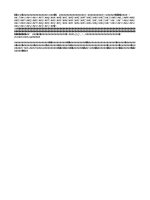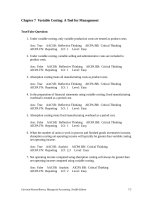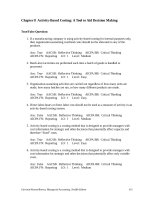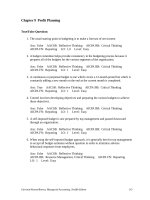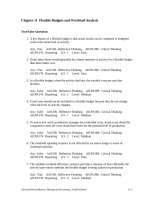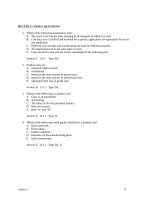Test bank managerial accounting 4e karen wilken braun ch1
Bạn đang xem bản rút gọn của tài liệu. Xem và tải ngay bản đầy đủ của tài liệu tại đây (672.61 KB, 60 trang )
Managerial Accounting, 4e (Braun/Tietz)
Chapter 1 Introduction to Managerial Accounting
1) Evaluating operations by comparing actual results to budgeted results is a part of the
controlling responsibility of management.
Answer: TRUE
Diff: 1
LO: 1-1
EOC: QC1-1
AACSB: Reflective thinking
Learning Outcome: Define and use cost-volume-profit analysis to analyze the effects of changes.
2) Controlling means overseeing the company's day-to-day operations.
Answer: FALSE
Diff: 1
LO: 1-1
EOC: QC1-1
AACSB: Reflective thinking
Learning Outcome: Define and use cost-volume-profit analysis to analyze the effects of changes.
3) The purpose of managerial accounting is to gather, summarize, and report the cost and
revenue data relevant to each decision that is made.
Answer: TRUE
Diff: 1
LO: 1-1
EOC: QC1-1
AACSB: Reflective thinking
Learning Outcome: Define and use cost-volume-profit analysis to analyze the effects of changes.
4) Budgeting is the process of evaluating the results of business operations against a plan
and then making adjustments to that plan.
Answer: FALSE
Diff: 1
LO: 1-1
EOC: QC1-1
AACSB: Reflective thinking
Learning Outcome: Define and use cost-volume-profit analysis to analyze the effects of changes.
5) Planning, directing, and controlling are a manager's three primary responsibilities.
Answer: TRUE
Diff: 1
LO: 1-1
EOC: QC1-1
AACSB: Reflective thinking
Learning Outcome: Define and use cost-volume-profit analysis to analyze the effects of changes.
1
Copyright © 2015 Pearson Education, Inc.
6) Managerial accounting develops reports that help internal parties effectively and
efficiently run the company.
Answer: TRUE
Diff: 1
LO: 1-2
EOC: S1-2
AACSB: Reflective thinking
Learning Outcome: Define and use cost-volume-profit analysis to analyze the effects of changes.
7) Directing means setting goals and objectives for the company and determining how to
achieve them.
Answer: FALSE
Diff: 1
LO: 1-1
EOC: S1-1
AACSB: Reflective thinking
Learning Outcome: Define and use cost-volume-profit analysis to analyze the effects of changes.
8) Budgets are the quantitative expression of management's plans.
Answer: TRUE
Diff: 1
LO: 1-1
EOC: S1-1
AACSB: Reflective thinking
Learning Outcome: Define and use cost-volume-profit analysis to analyze the effects of changes.
9) ________ gathers, summarizes, and reports on the financial impact of changes to business
operations.
A) Managerial accounting
B) Planning
C) Directing
D) Controlling
Answer: A
Diff: 2
LO: 1-1
EOC: S1-1
AACSB: Reflective thinking
Learning Outcome: Define and use cost-volume-profit analysis to analyze the effects of changes.
10) Creating budgets are part of which primary management responsibility?
A) Controlling
B) Planning
C) Managerial accounting
D) Directing
Answer: B
Diff: 2
LO: 1-1
EOC: S1-1
AACSB: Reflective thinking
Learning Outcome: Define and use cost-volume-profit analysis to analyze the effects of changes.
2
Copyright © 2015 Pearson Education, Inc.
11) Which of the following is not one of the primary responsibilities of management?
A) Adhering to GAAP
B) Planning
C) Directing
D) Controlling
Answer: A
Diff: 2
LO: 1-1
EOC: S1-1
AACSB: Reflective thinking
Learning Outcome: Define and use cost-volume-profit analysis to analyze the effects of changes.
12) Planning involves which of the following activities?
A) Evaluating the results of operations
B) Overseeing the company's day-to-day operations
C) Setting goals and objectives for the company
D) None of the above
Answer: C
Diff: 1
LO: 1-1
EOC: S1-1
AACSB: Reflective thinking
Learning Outcome: Define and use cost-volume-profit analysis to analyze the effects of changes.
13) Which of the following is being fulfilled when management compares the budget to
actual results?
A) Directing
B) Planning
C) Adjusting
D) Controlling
Answer: D
Diff: 2
LO: 1-1
EOC: S1-1
AACSB: Reflective thinking
Learning Outcome: Define and use cost-volume-profit analysis to analyze the effects of changes.
14) When management uses feedback to take corrective action on the budgets, which of the
following management responsibilities are being fulfilled?
A) Controlling
B) Adjusting
C) Directing
D) Planning
Answer: A
Diff: 2
LO: 1-1
EOC: S1-1
AACSB: Reflective thinking
Learning Outcome: Define and use cost-volume-profit analysis to analyze the effects of changes.
3
Copyright © 2015 Pearson Education, Inc.
15) When management analyzes whether to move production to another country or to keep
the production located where it currently is, which of the following management
responsibilities is being performed?
A) Adjusting
B) Controlling
C) Planning
D) Directing
Answer: C
Diff: 3
LO: 1-1
EOC: S1-1
AACSB: Reflective thinking
Learning Outcome: Define and use cost-volume-profit analysis to analyze the effects of changes.
16) Which one of the following items is not one of the three primary manager
responsibilities?
A) Controlling
B) Planning
C) Directing
D) Adjusting
Answer: D
Diff: 2
LO: 1-1
EOC: S1-1
AACSB: Reflective thinking
Learning Outcome: Define and use cost-volume-profit analysis to analyze the effects of changes.
17) Using product cost information to determine sales prices is an example of
A) directing.
B) directing and controlling.
C) controlling, directing, and planning.
D) controlling and planning.
Answer: A
Diff: 3
LO: 1-1
EOC: S1-1
AACSB: Reflective thinking
Learning Outcome: Define and use cost-volume-profit analysis to analyze the effects of changes.
4
Copyright © 2015 Pearson Education, Inc.
18) When management reviews product sales reports to set goals and objectives and then
evaluates the results of sales operations against the plan and performance results, which of
management's three primary responsibilities is fulfilled?
A) Controlling and planning
B) Directing and planning
C) Directing, controlling, and planning
D) Analyzing, directing, and planning
Answer: C
Diff: 3
LO: 1-1
EOC: S1-1
AACSB: Reflective thinking
Learning Outcome: Define and use cost-volume-profit analysis to analyze the effects of changes.
19) Budgets are a way for managers to communicate their
A) control.
B) decision-making.
C) hiring practices.
D) plans.
Answer: D
Diff: 1
LO: 1-1
EOC: S1-1
AACSB: Reflective thinking
Learning Outcome: Define and use cost-volume-profit analysis to analyze the effects of changes.
20) Comparing actual results to budgets is an example of which of the following
management functions?
A) Analyzing
B) Planning
C) Controlling
D) Directing
Answer: C
Diff: 1
LO: 1-1
EOC: S1-1
AACSB: Reflective thinking
Learning Outcome: Define and use cost-volume-profit analysis to analyze the effects of changes.
21) Overseeing the day-to-day operations of a company is an example of which of the
following management functions?
A) Directing
B) Planning
C) Analyzing
D) Controlling
Answer: A
Diff: 1
LO: 1-1
EOC: S1-1
AACSB: Reflective thinking
Learning Outcome: Define and use cost-volume-profit analysis to analyze the effects of changes.
22) Preparing budgets is an example of which of the following management functions?
A) Planning
B) Directing
C) Analyzing
D) Controlling
Answer: A
5
Copyright © 2015 Pearson Education, Inc.
Diff: 1
LO: 1-1
EOC: S1-1
AACSB: Reflective thinking
Learning Outcome: Define and use cost-volume-profit analysis to analyze the effects of changes.
23) Evaluating results against the plan is an example of which of the following management
functions?
A) Planning
B) Controlling
C) Analyzing
D) Directing
Answer: B
Diff: 1
LO: 1-1
EOC: S1-1
AACSB: Reflective thinking
Learning Outcome: Define and use cost-volume-profit analysis to analyze the effects of changes.
24) What are the three primary responsibilities of managers that use managerial accounting
as described in the chapter? Give an example of each type of responsibility applicable to a
managerial accountant.
Answer: The following are managers' three primary responsibilities:
a. Planning: An example of planning is when the manager of a local McDonald's restaurant
makes the schedule of employee work hours for the upcoming week.
b. Directing: An example of directing is when the manager of the local McDonald's adjusts
the menu to reflect local tastes and preferences.
c. Controlling: An example of controlling is when the manager of the local McDonald's
compares the actual number of hamburger patties used over the past week to the budgeted
number of hamburger patties.
Note that student examples of each type of responsibility may vary.
Diff: 2
LO: 1-1
EOC: S1-1
AACSB: Reflective thinking
Learning Outcome: Define and use cost-volume-profit analysis to analyze the effects of changes.
6
Copyright © 2015 Pearson Education, Inc.
25) The managerial accountant at Strategic Group Consulting reported the following
information about the sales budget for the period ending December 31, 20XX:
Observe the Sales Budget and determine which primary responsibility the managerial
accountant uses to
determine which quarter generated the most per-unit product sales data in order to adjust
the marketing strategy?
A) Planning
B) Controlling
C) Directing
D) Analyzing
E) Eliminating
Answer: C
Explanation: C) The managerial accountant used the directing responsibility in managerial
accounting to determine which quarter generated the most sales. This information is
important to a manager because the information found in the sales budget report can help
the manager adjust the marketing strategy.
Diff: 3
LO: 1-1
EOC: S1-1; A1-32-1
AACSB: Analytical thinking
Learning Outcome: Define and use cost-volume-profit analysis to analyze the effects of changes in
costs and volume on a company's profits.
7
Copyright © 2015 Pearson Education, Inc.
26) Managerial accountants fulfill three primary responsibilities: planning, directing and
controlling. Review each of the following tasks that managerial accountants complete in
their role as a managerial accountant:
(a)The manager at the Pet Store holds a meeting with staff to set goals and to ask
the employees how to achieve the goals.
(b)The manager at the Home Goods Store realized that the actual sales are lower
than planned and the manager schedules a meeting to revise plans or adjust the
operations.
(c) The local manager at the Halloween Store uses product sales data to determine
which costumes generate the most sales and then he or she can use that
information to establish seasonal marketing strategies.
(d)The manager at the Children's Hospital translates plans into budgets because he
or she wants to see the quantitative expression of the plan.
(e)A manager decides to increase local advertising at the Children's Toy Store.
In the space provided below, indicate whether the task is (1) planning; (2) directing; or, (3)
controlling.
Planning
Directing
Controlling
Answer:
(a) Planning: The manager at the Pet Store is planning in this scenario holds a meeting with
staff to set goals and discuss how to achieve those goals. Recall that planning involves
setting goals and objectives for the company and determining how to achieve those goals.
(b) Controlling: The manager at the Home Goods Store uses the controlling responsibility.
Recall that the controlling responsibility means that a manager evaluates the results against
the budget and then uses feedback to take corrective action. A manager that reveals that
actual sales are lower than planned can schedule a meeting and revise plans or adjust
operations to accommodate new objectives.
(c) Directing: The manager at the Halloween Store is directing when he or she uses product
sales data to determine which costumes generate the most sales and then uses that
information to establish seasonal marketing strategies.
(d) Planning: A manager at the Children's Hospital uses the planning responsibility when he
or she translates plans into budgets because he or she wants to observe the quantitative
expression of the plan.
(e) Controlling: The manager at the Children's Toy Store increases local advertising to
increase sales in the region. The manager uses the controlling responsibility.
Diff: 3
LO: 1-1
EOC: S1-1; A1-32-1
AACSB: Analytical thinking
Learning Outcome: Define and use cost-volume-profit analysis to analyze the effects of changes in
costs and volume on a company's profits.
8
Copyright © 2015 Pearson Education, Inc.
27) The management accountant at Technology Innovators determined $500,000 is the
organization's earning goal to accommodate the organizational plan during the first quarter
during a new year. The accountant realizes that to achieve the new earning goal, the
operations manager needs to increase the price of technology parts charged to a consumer
to $250.00 per unit. The manager is scheduling a new staff meeting to determine if they
need to increase the marketing efforts at the firm, or if they need to design a new part that
uses materials that are less expensive to produce.
Which of the following management responsibilities is the managerial accountant using in
this example?
A) Directing
B) Planning
C) Controlling
D) Implementing
E) Designing
Answer: B
Explanation: B) The management accountant is using the planning responsibility in this
example. Recall that in the planning responsibility, managerial accountants set goals and
objectives for the organization; and, they determine how to achieve those goals. A
managerial accountant can also translate a plan into a budget to perform a quantitative
analysis. The managerial accountant analyzes the budget before proceeding with the budget
since the managerial accountant determines whether or not the plan is feasible based on
the results of the analysis.
Diff: 3
LO: 1-1
EOC: S1-1; A1-32-1
AACSB: Analytical thinking
Learning Outcome: Define and use cost-volume-profit analysis to analyze the effects of changes in
costs and volume on a company's profits.
9
Copyright © 2015 Pearson Education, Inc.
28) The management accountant at Woodhaven Cycle Shoppe developed a budget to
establish the sales goals at the store in 2012. In 2013, the management accountant
evaluated the performance in the organization, reviewed the performance of the sales staff,
and compared the sales results to the actual budget that the managerial accountant
developed in 2012.
Which of the following management accounting responsibilities is the management
accountant using in this example?
A) Planning
B) Directing
C) Controlling
D) Designing
E) Implementing
Answer: C
Explanation: C) The management accountant at Woodhaven Cycle Shoppe is using the
controlling responsibility in this example. Recall that in the controlling responsibility a
managerial accountant evaluates the business operations against the plan, makes any
changes or adjustments that ensure the smooth operation of the plan.
Diff: 3
LO: 1-1
EOC: S1-1; A1-32-1
AACSB: Analytical thinking
Learning Outcome: Define and use cost-volume-profit analysis to analyze the effects of changes in
costs and volume on a company's profits.
10
Copyright © 2015 Pearson Education, Inc.
29) The management accountant at Light Manufacturing oversees the company's day-to-day
operations at the firm. The management accountant observed that the company generated
$800,000 in product sales and the management accountant uses that information to run the
daily business operations. The information is also to the management accountant because
the data reveals which products generate the most sales; and, the management accountant
uses that information to adjust products and develop the marketing strategy.
Which of the following management accounting responsibilities is the management
accountant using in this example?
A) Planning
B) Directing
C) Controlling
D) Designing
E) Implementing
Answer: B
Explanation: B) The management accountant at Light Manufacturing is using the directing
responsibility in the example. Recall that in the directing responsibility, managerial
accountants oversee the company's day-to-day operations. The managerial accountant
typically uses product cost reports, product sales information, or other reports needed to run
the daily operations in the business. The managerial accountant used the directing
responsibility to reveal which products earned the most sales and the managerial
accountant used that information to adjust products and develop the new or revised
marketing strategy.
Diff: 3
LO: 1-1
EOC: S1-1; A1-32-1
AACSB: Analytical thinking
Learning Outcome: Define and use cost-volume-profit analysis to analyze the effects of changes in
costs and volume on a company's profits.
30) The SEC requires an independent certified public accountant (CPA) to audit reports
generated by managerial accounting systems.
Answer: FALSE
Diff: 2
LO: 1-2
EOC: E1-17B
AACSB: Reflective thinking
Learning Outcome: Define and use cost-volume-profit analysis to analyze the effects of changes.
31) The design of a management accounting system should consider how reports affect
employees' behavior.
Answer: TRUE
Diff: 2
LO: 1-2
EOC: E1-17B
AACSB: Reflective thinking
Learning Outcome: Define and use cost-volume-profit analysis to analyze the effects of changes.
11
Copyright © 2015 Pearson Education, Inc.
32) Managerial accountants must comply with Generally Accepted Accounting Principles
(GAAP) standards when they prepare managerial accounting reports.
Answer: FALSE
Diff: 1
LO: 1-2
EOC: QC1-2
AACSB: Reflective thinking
Learning Outcome: Define and use cost-volume-profit analysis to analyze the effects of changes.
33) Management accounting requires an independent audit of the firm's books.
Answer: FALSE
Diff: 1
LO: 1-2
EOC: S1-2
AACSB: Reflective thinking
Learning Outcome: Define and use cost-volume-profit analysis to analyze the effects of changes.
34) The primary purpose of managerial accounting information is to help external users
make investing and lending decisions.
Answer: FALSE
Diff: 1
LO: 1-2
EOC: S1-2
AACSB: Reflective thinking
Learning Outcome: Define and use cost-volume-profit analysis to analyze the effects of changes.
35) Managers and other internal users are the primary users of managerial accounting
information.
Answer: TRUE
Diff: 1
LO: 1-2
EOC: S1-2
AACSB: Reflective thinking
Learning Outcome: Define and use cost-volume-profit analysis to analyze the effects of changes.
36) The primary managerial accounting product is the company's audited financial
statements.
Answer: FALSE
Diff: 1
LO: 1-2
EOC: S1-2
AACSB: Reflective thinking
Learning Outcome: Define and use cost-volume-profit analysis to analyze the effects of changes.
37) Managerial accounting information emphasizes relevance over reliability and objectivity.
Answer: TRUE
Diff: 1
LO: 1-2
EOC: S1-2
AACSB: Reflective thinking
Learning Outcome: Define and use cost-volume-profit analysis to analyze the effects of changes.
12
Copyright © 2015 Pearson Education, Inc.
38) Managerial accounting information tends to report on segments of the business.
Answer: TRUE
Diff: 1
LO: 1-2
EOC: S1-2
AACSB: Reflective thinking
Learning Outcome: Define and use cost-volume-profit analysis to analyze the effects of changes.
39) Managerial accounting reports are always prepared on a quarterly and annual basis.
Answer: FALSE
Diff: 1
LO: 1-2
EOC: S1-2
AACSB: Reflective thinking
Learning Outcome: Define and use cost-volume-profit analysis to analyze the effects of changes.
40) Managerial accounting information is always based on historical transactions with
external parties.
Answer: FALSE
Diff: 1
LO: 1-2
EOC: S1-2
AACSB: Reflective thinking
Learning Outcome: Define and use cost-volume-profit analysis to analyze the effects of changes.
41) What do managers weigh to develop and run their accounting systems?
A) Generally Accepted Accounting Principles (GAAP)
B) SEC Regulations
C) Cost-Benefit
D) International Financial Reporting Standards (IFRS)
Answer: C
Diff: 1
LO: 1-2
EOC: S1-2
AACSB: Reflective thinking
Learning Outcome: Define and use cost-volume-profit analysis to analyze the effects of changes.
42) How often should managerial accounting reports be prepared?
A) Annually
B) Quarterly
C) Monthly
D) As often as necessary
Answer: D
Diff: 1
LO: 1-2
EOC: S1-2
AACSB: Reflective thinking
Learning Outcome: Define and use cost-volume-profit analysis to analyze the effects of changes.
13
Copyright © 2015 Pearson Education, Inc.
43) Which of the following statements is true regarding managerial accounting information?
A) Managerial accounting information is audited by CPAs.
B) Managerial accounting information emphasizes relevance.
C) Managerial accounting information is prepared annually and quarterly.
D) Managerial accounting information must be prepared in conformity with Generally
Accepted Accounting Principles (GAAP).
Answer: B
Diff: 1
LO: 1-2
EOC: S1-2
AACSB: Reflective thinking
Learning Outcome: Define and use cost-volume-profit analysis to analyze the effects of changes.
44) The focus of management accounting is on
A) tax preparation.
B) external reporting.
C) internal reporting.
D) auditing.
Answer: C
Diff: 1
LO: 1-2
EOC: S1-2
AACSB: Reflective thinking
Learning Outcome: Define and use cost-volume-profit analysis to analyze the effects of changes.
45) Which of the following individual is the only individual to use financial accounting
information?
A) Vice president of plant operations
B) Product manager
C) Plant manager
D) Bank credit officer
Answer: D
Diff: 1
LO: 1-2
EOC: S1-2
AACSB: Reflective thinking
Learning Outcome: Define and use cost-volume-profit analysis to analyze the effects of changes.
46) Managerial accounting would use which of the following types of information?
A) Forecasts of future earnings
B) Financial information
C) Nonfinancial information
D) All of the above
Answer: D
Diff: 1
LO: 1-2
EOC: S1-2
AACSB: Reflective thinking
Learning Outcome: Define and use cost-volume-profit analysis to analyze the effects of changes.
14
Copyright © 2015 Pearson Education, Inc.
47) Which of the following persons or groups would be least likely to receive detailed
managerial accounting reports?
A) CEO
B) Plant managers
C) Current shareholders
D) Sales territory managers
Answer: C
Diff: 1
LO: 1-2
EOC: S1-2
AACSB: Reflective thinking
Learning Outcome: Define and use cost-volume-profit analysis to analyze the effects of changes.
48) ________ is designed to meet the needs of internal decision makers.
A) Tax accounting
B) Managerial accounting
C) Financial accounting
D) Audit accounting
Answer: B
Diff: 1
LO: 1-2
EOC: S1-2
AACSB: Reflective thinking
Learning Outcome: Define and use cost-volume-profit analysis to analyze the effects of changes.
49) The primary goal of managerial accounting is to provide information to
A) internal decision-makers.
B) shareholders.
C) creditors.
D) both shareholders and creditors.
Answer: A
Diff: 1
LO: 1-2
EOC: S1-2
AACSB: Reflective thinking
Learning Outcome: Define and use cost-volume-profit analysis to analyze the effects of changes.
50) The primary goal of financial accounting is to provide information to
A) government regulators.
B) creditors.
C) potential investors.
D) all of the above.
Answer: D
Diff: 1
LO: 1-2
EOC: S1-2
AACSB: Reflective thinking
Learning Outcome: Define and use cost-volume-profit analysis to analyze the effects of changes.
15
Copyright © 2015 Pearson Education, Inc.
51) Which of following statements is true?
A) Managerial accounting focuses on historical transactions.
B) Financial accounting focuses on future data.
C) Management accounting focuses on relevant data.
D) Managerial accounting uses the cash basis for recording transactions.
Answer: C
Diff: 2
LO: 1-2
EOC: S1-2
AACSB: Reflective thinking
Learning Outcome: Define and use cost-volume-profit analysis to analyze the effects of changes.
52) Which statement is true?
A) Management uses financial information to analyze costs.
B) Management uses financial information to plan internal operations.
C) Management uses reports created for internal parties.
D) All of the above are true.
Answer: D
Diff: 2
LO: 1-2
EOC: S1-2
AACSB: Analytical thinking
Learning Outcome: Define and use cost-volume-profit analysis to analyze the effects of changes.
53) Which of the following statements is false about financial accounting?
A) Financial accounting helps investors make decisions.
B) Financial accounting provides sufficient information for managers to effectively plan and
control operations.
C) Financial accounting reports help creditors make decisions.
D) Financial accounting provides external reports.
Answer: B
Diff: 2
LO: 1-2
EOC: S1-2
AACSB: Analytical thinking
Learning Outcome: Define and use cost-volume-profit analysis to analyze the effects of changes.
54) Which of the following statements is true about managerial accounting?
A) Managerial accounting reports aid potential investors.
B) Managerial accounting reports must follow GAAP.
C) Managerial accounting reports are audited by CPAs.
D) Managerial accounting reports provide detailed internal information.
Answer: D
Diff: 2
LO: 1-2
EOC: S1-2
AACSB: Analytical thinking
Learning Outcome: Define and use cost-volume-profit analysis to analyze the effects of changes.
16
Copyright © 2015 Pearson Education, Inc.
55) Which of the following are the internal decision makers of a company?
A) Vendors
B) Managers
C) Shareholders
D) Customers
Answer: B
Diff: 1
LO: 1-2
EOC: E1-12A; E1-17B
AACSB: Reflective thinking
Learning Outcome: Define and use cost-volume-profit analysis to analyze the effects of changes.
56) Which one of the following financial reports is required to be audited by an outside
entity?
A) Monthly financial statements
B) Annual financial budgets
C) Annual financial statements
D) All of the above
Answer: C
Diff: 2
LO: 1-2
EOC: E1-12A; E1-17B
AACSB: Reflective thinking
Learning Outcome: Define and use cost-volume-profit analysis to analyze the effects of changes.
57) Which of the following groups are external users of financial information?
A) Customers of the company
B) Potential investors of the company
C) Vendors of the company
D) All of the above
Answer: D
Diff: 1
LO: 1-2
EOC: E1-12A; E1-17B
AACSB: Reflective thinking
Learning Outcome: Define and use cost-volume-profit analysis to analyze the effects of changes.
58) A company's budget information is most likely to be used by which of the following
groups?
A) Suppliers
B) Creditors
C) Customers
D) Managers
Answer: D
Diff: 1
LO: 1-2
EOC: E1-12A; E1-17B
AACSB: Reflective thinking
Learning Outcome: Define and use cost-volume-profit analysis to analyze the effects of changes.
17
Copyright © 2015 Pearson Education, Inc.
59) ________ are a company's decision makers.
A) Shareholders
B) Managers
C) Customers
D) Creditors
Answer: B
Diff: 1
LO: 1-2
EOC: E1-12A; E1-17B
AACSB: Reflective thinking
Learning Outcome: Define and use cost-volume-profit analysis to analyze the effects of changes.
60) ________ are owners of a company.
A) Customers
B) Shareholders
C) Creditors
D) Managers
Answer: B
Diff: 1
LO: 1-2
EOC: E1-12A; E1-17B
AACSB: Reflective thinking
Learning Outcome: Define and use cost-volume-profit analysis to analyze the effects of changes.
61) An external party receives information about past performance from
A) planning reports.
B) budget reports.
C) financial statements.
D) internal managerial accounting reports.
Answer: C
Diff: 1
LO: 1-2
EOC: E1-12A; E1-17B
AACSB: Reflective thinking
Learning Outcome: Define and use cost-volume-profit analysis to analyze the effects of changes.
62) Internal parties receive information about past performance from
A) audit reports.
B) budget reports.
C) planning reports.
D) managerial accounting reports.
Answer: D
Diff: 1
LO: 1-2
EOC: S1-2
AACSB: Reflective thinking
Learning Outcome: Define and use cost-volume-profit analysis to analyze the effects of changes.
18
Copyright © 2015 Pearson Education, Inc.
63) Discuss at least four differences between financial accounting and managerial
accounting.
Answer:
Item
Managerial accounting Financial accounting
Primary users
Internal
External
Purpose of
To help managers make
To help investors and
information
decisions
creditors make decisions
Entire organization as a
Focus
Segments
whole
Frequency
As needed
Quarterly and annually
Publicly held companies
Auditing
Not subject to audit
are audited
Required by GAAP, SEC,
Required?
No
IRS, and others
Past (historical
Time frame focus
Future
transactions)
Diff: 2
LO: 1-2
EOC: S1-2
AACSB: Reflective thinking
Learning Outcome: Define and use cost-volume-profit analysis to analyze the effects of changes.
64) Is financial accounting or managerial accounting more useful to a plant (factory)
manager? Explain your answer.
Answer: Managerial accounting is more useful to a plant manager compared to financial
accounting since financial accounting typically gives financial information for the company
as a whole. The plant manager would find very little information in the financial accounting
reports that relate directly to the plant environment and the performance of the plant itself.
Managerial accounting could provide the plant manager with information relating to the
plant individually. Examples of types of information provided by managerial accounting are:
a. a comparison of budgeted costs versus actual costs.
b. tracking of safety incidents.
c. quality costs.
d. product line profitability.
e. profitability by shift.
(Student examples may vary.)
Diff: 2
LO: 1-2
EOC: S1-2
AACSB: Reflective thinking
Learning Outcome: Define and use cost-volume-profit analysis to analyze the effects of changes.
19
Copyright © 2015 Pearson Education, Inc.
65) In 2013, the accountant at Star Incorporated, a national time-share company, focused on
an internal sales report that illustrates the sales projections to ensure the sales
representatives achieve their goals in 2013; however, the report was not prepared in
accordance with GAAP. The accountant observed that the total sales produced by the sales
representatives in 2012 were $250,000,000. The accountant is in the process of establishing
the new 2013 sales goals for the sales representatives and the accountant is concerned
about the new sales goals in 2013 since the economy is slow and many individuals and
groups are not purchasing time-share condos.
Is the accountant a management accountant or a financial accountant? What concept
concerns the accountant when the new sales goals are revealed to the sales representatives
and administrative staff? Why?
Answer: The accountant at Star Incorporated is a management accountant. Management
accountants focus on internal reports that focus on the future; and, the internal reports at
the business are not prepared in accordance with GAAP. The management accountant is
concerned about how the new sales goals will impact the behavior of the employees.
Diff: 3
LO: 1-2
EOC: S1-2
AACSB: Analytical thinking
Learning Outcome: Define and use cost-volume-profit analysis to analyze the effects of changes in
costs and volume on a company's profits.
66) In 2013, the employee at Lighthouse Services prepared an annual report for the bank
that revealed total revenue in 2012 was $6,000,000. The manager needs the information to
apply for a loan to purchase new equipment to maintain the operations at the organization.
The report was prepared in accordance with GAAP and the report contained information
about the 2012 financial performance at the company.
Which of the following describes the role of the employee at Lighthouse Services?
A) Managerial Accountant
B) CFO
C) CEO
D) Board of Director
E) Financial Accountant
Answer: E
Explanation: E) The accountant at Lighthouse Services is a financial accountant. Financial
accountants focus on the external users of reports and the summary reports focus on the
entire organization in accordance with GAAP; and, the reports focus on past data.
Diff: 3
LO: 1-2
EOC: S1-2
AACSB: Analytical thinking
Learning Outcome: Define and use cost-volume-profit analysis to analyze the effects of changes in
costs and volume on a company's profits.
20
Copyright © 2015 Pearson Education, Inc.
67) Review the following individual accounting system components that contain the skills
and capabilities of individuals in Chart A and review the accounting system components that
contain the skills and capabilities of individuals in Chart B.
Accounting Systems: Skills and
Capabilities Chart A
•Analytical skills
•Verbal and written communication skills
•Accounting and business knowledge
•Teamwork abilities
Accounting Systems: Skills and
Capabilities Chart B
•Producing annual and quarterly
statements
•Statements prepared in accordance to
GAAP
•Statements useful to external users
•Annual financial statements audited by
an independent CPA
Which of the following describes the individual required to perform the accounting system
skills and capabilities in Chart A and which individual is the responsible individual required to
perform the skills and capabilities in Chart B?
A) Chart A: Independent Auditor; Chart B: Internal Audit Function
B) Chart A: Managerial Accountant; Chart B: Financial Accountant
C) Chart A: Audit Committee; Chart B: Cross Functional Teams
D) Chart A: Cross Functional Teams; Chart B: Treasurer
E) Chart A: Controller; Chart B: Treasurer
Answer: B
Explanation: B) Chart A contains the skills and capabilities of a management accountant
system; and, Chart B contains the skills and capabilities of a financial accountant accounting
system. Recall that managerial accounting systems provide managers with the information
needed to plan, direct, and control the operations in the organization; whereas financial
accounting systems produce annual and quarterly consolidated financial statements used by
investors and creditors. The financial systems contain reports that are produced on an
annual or quarterly basis; and, they are prepared in accordance to GAAP.
Diff: 3
LO: 1-2
EOC: S1-2
AACSB: Analytical thinking
Learning Outcome: Define and use cost-volume-profit analysis to analyze the effects of changes in
costs and volume on a company's profits.
21
Copyright © 2015 Pearson Education, Inc.
68) The new accountant at the Holiday Card Shoppe reviewed the following information:
Is the system a financial system or a managerial system? Is the accountant at the Holiday
Card Shoppe a managerial accountant or a financial accountant? Why?
Answer: The budget report is an example of a managerial accounting system. The budget
report illustrates the future allowance to each unit in a different region; and, the report
illustrates the cost to transport the cards from the central warehouse to individual units. The
managerial accountant at Holiday Card Shoppe is a managerial accountant. Recall that
managerial accounting system reports focus on the future and the reports provide relevant
information that helps managers make business decisions.
Diff: 3
LO: 1-2
EOC: S1-2
AACSB: Analytical thinking
Learning Outcome: Define and use cost-volume-profit analysis to analyze the effects of changes in
costs and volume on a company's profits.
22
Copyright © 2015 Pearson Education, Inc.
69) The new employee at Cork Manufacturing reported to work and the employee reviewed
the following information that was audited by the CPA:
Which of the following describes the role of the new employee?
A) Managerial Accountant
B) Financial Accountant
C) CEO
D) Receptionist
E) Secretary
Answer: B
Explanation: B) The employee is a financial accountant. The consolidated balance
worksheet was prepared in accordance to GAAP. Recall that accounting financial systems are
generated toward producing annual and quarterly consolidated financial statements. The
SEC requires independent CPAs to audit the annual financial statements.
Diff: 3
LO: 1-2
EOC: S1-2
AACSB: Analytical thinking
Learning Outcome: Define and use cost-volume-profit analysis to analyze the effects of changes in
costs and volume on a company's profits.
23
Copyright © 2015 Pearson Education, Inc.
70) Management accountants rarely interact with employees from other business functions
such as marketing and customer service.
Answer: FALSE
Diff: 1
LO: 1-3
EOC: S1-5
AACSB: Reflective thinking
Learning Outcome: Define and use cost-volume-profit analysis to analyze the effects of changes.
71) The CFO is the person responsible for the day-to-day operations of the company.
Answer: FALSE
Diff: 1
LO: 1-3
EOC: S1-5
AACSB: Reflective thinking
Learning Outcome: Define and use cost-volume-profit analysis to analyze the effects of changes.
72) The treasurer and the controller report directly to the CFO.
Answer: TRUE
Diff: 1
LO: 1-3
EOC: S1-5
AACSB: Reflective thinking
Learning Outcome: Define and use cost-volume-profit analysis to analyze the effects of changes.
73) The internal audit department reports directly to the audit committee, a subcommittee
of the board of directors.
Answer: TRUE
Diff: 1
LO: 1-3
EOC: S1-5
AACSB: Reflective thinking
Learning Outcome: Define and use cost-volume-profit analysis to analyze the effects of changes.
74) Managerial accountants no longer perform routine mechanical accounting tasks in most
companies.
Answer: TRUE
Diff: 1
LO: 1-3
EOC: QC1-4
AACSB: Reflective thinking
Learning Outcome: Define and use cost-volume-profit analysis to analyze the effects of changes.
75) Managerial accountants are now considered to be similar to internal consultants and
business advisors.
Answer: TRUE
Diff: 1
LO: 1-3
EOC: QC1-4
AACSB: Reflective thinking
Learning Outcome: Define and use cost-volume-profit analysis to analyze the effects of changes.
24
Copyright © 2015 Pearson Education, Inc.
76) Oral and written communications skills are considered among the skills that are critical
to management accountants.
Answer: TRUE
Diff: 1
LO: 1-3
EOC: QC1-4
AACSB: Reflective thinking
Learning Outcome: Define and use cost-volume-profit analysis to analyze the effects of changes.
77) Technology has been a driving factor in the changing roles of management accountants.
Answer: TRUE
Diff: 1
LO: 1-3
EOC: S1-3
AACSB: Reflective thinking
Learning Outcome: Define and use cost-volume-profit analysis to analyze the effects of changes.
78) Management accountants spend more time planning, analyzing and interpreting
accounting data and less time recording routine mechanical work.
Answer: TRUE
Diff: 1
LO: 1-3
EOC: S1-3
AACSB: Reflective thinking
Learning Outcome: Define and use cost-volume-profit analysis to analyze the effects of changes.
79) The only skill required of managerial accountants is that they have a solid knowledge of
both financial and managerial accounting.
Answer: FALSE
Diff: 1
LO: 1-3
EOC: S1-3
AACSB: Reflective thinking
Learning Outcome: Define and use cost-volume-profit analysis to analyze the effects of changes.
80) Managerial accountants only need a solid understanding of managerial accounting, and
not financial accounting.
Answer: FALSE
Diff: 1
LO: 1-3
EOC: S1-3
AACSB: Reflective thinking
Learning Outcome: Define and use cost-volume-profit analysis to analyze the effects of changes.
25
Copyright © 2015 Pearson Education, Inc.

